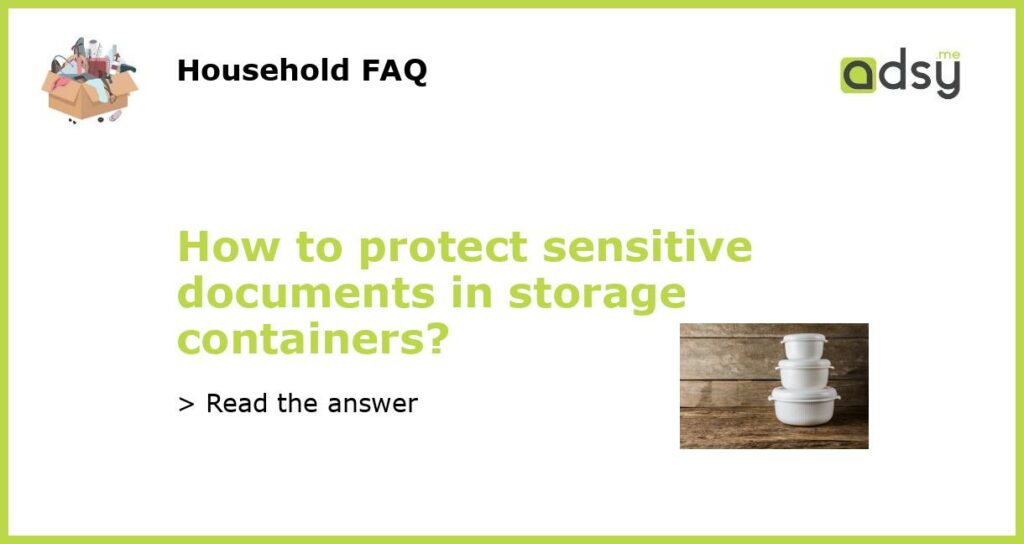Understanding the Importance of Document Protection
Protecting sensitive documents is crucial for businesses and individuals alike. Whether it’s personal information, proprietary data, or confidential client records, the consequences of a security breach can be severe. From identity theft and financial loss to reputational damage, the risks associated with unprotected documents can be significant.
Choosing the Right Storage Containers
The first step in protecting sensitive documents is selecting the right storage containers. There are various options available, each with its own pros and cons. Here are a few popular choices:
- Lockable File Cabinets: Lockable file cabinets offer a simple and secure solution for document storage. They come in different sizes and can be easily integrated into any office environment. Ensure that the lock mechanism is reliable and can withstand unauthorized access.
- Lockable Storage Boxes: These boxes are designed specifically for document storage and come with built-in locks. They are often made of durable materials like metal or heavy-duty plastic, providing an added layer of security.
- Vertical Filing Cabinets: Vertical filing cabinets are a popular choice for organizing and storing documents. They typically have multiple drawers that can be locked individually. This allows for easy organization while maintaining document security.
- Mobile Pedestal File Cabinets: These cabinets offer the convenience of mobility and are ideal for shared workspaces or offices with limited floor space. Look for cabinets with locking mechanisms that are resistant to tampering.
Implementing Document Organization and Access Control
Once you have selected the right storage containers, it’s important to establish an effective document organization and access control system. This will ensure that sensitive information is properly categorized, easily retrievable, and only accessible to authorized individuals.
Here are some best practices for document organization and access control:
- Categorize Documents: Create categories or folders based on the type of information and its sensitivity level. This will make it easier to locate specific documents and enforce access restrictions.
- Labeling: Clearly label each storage container and folder to indicate its contents and level of sensitivity. This will help prevent accidental access and ensure that documents are returned to the correct location after use.
- Access Control: Implement a system that controls who can access sensitive documents. This can include physical keys, combination locks, electronic access cards, or biometric scanners.
- Regular Audits: Conduct regular audits to ensure that access privileges are up to date and that documents are stored in their designated locations.
Implementing Digital Document Security Measures
In addition to physical document protection, it’s essential to implement digital security measures to safeguard sensitive information stored electronically. Here are some steps you can take:
- Endpoint Security Software: Install endpoint security software on all devices used to access sensitive documents. This software provides protection against malware, unauthorized access, and other potential threats.
- Data Encryption: Encrypt sensitive documents before storing them on digital devices or in cloud storage. Encryption ensures that even if someone gains unauthorized access to the files, they won’t be able to read the contents without the encryption key.
- Password Protection: Implement strong password policies for accessing digital documents. Encourage the use of complex passwords and enable multi-factor authentication whenever possible.
- Secure File Sharing: Use secure file-sharing platforms that encrypt data during transit and provide granular access controls. Avoid sending sensitive documents via unsecured email or file transfer methods.
- Data Backups: Regularly back up sensitive documents to a secure, off-site location. This will prevent data loss in the event of a hardware failure, natural disaster, or cyberattack.
Educating Employees on Document Security Best Practices
Lastly, document security is a team effort, and employees play a crucial role in protecting sensitive information. It’s essential to educate employees on document security best practices and provide regular training sessions to reinforce these principles. Here are some topics to cover:
- Importance of Document Security: Explain the potential risks and consequences of document breaches and the impact on individuals and the organization.
- Data Classification: Teach employees how to identify sensitive information and the appropriate storage and handling procedures for each category.
- Access Control: Instruct employees on the importance of keeping documents secure, sharing sensitive information only with authorized personnel, and reporting any suspicious activity.
- Use of Technology: Train employees on the safe use of digital devices, email security, secure file sharing, and data encryption techniques.
- Physical Security: Remind employees to lock their workstations and offices when not in use, avoid leaving sensitive documents unattended, and follow proper document disposal procedures.






